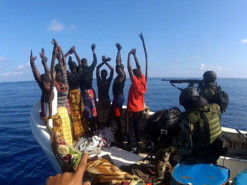Posted on 11 May 2017
By Lucia Bird and Karsten von Hoesslin
Introduction
The ‘eradication’ of Somali piracy in 2012 was heralded as a key success story for international intervention, and the operational structure advertised as a panacea for counter-piracy initiatives globally. Warnings that Somali piracy was merely experiencing a lull and would inevitably return were largely ignored. A spate of successful hijackings, the first since 2012, appear to have proven such warnings correct.
South East Asian piracy, predominantly involving product theft rather than kidnap-for-ransom, has traditionally failed to catch headlines to an extent comparable with its more violent Somali cousin. Although hijackings for product theft hit a five-year low in 2016, an upsurge in kidnap-for-ransom incidents have catalysed promises of heightened regional cooperation between littoral states.
The Return of Somali piracy?
International presence in the Gulf of Aden has, surreptitiously, decreased since 2012 as the risk perception has lowered and international appetite for continuing to invest resources has diminished in a time of fiscal crisis. Most recently, and perhaps ironically, a NATO force was disbanded in December 2016 due to a lack of pirate attacks, although an EU naval force remains. The 2017 spate of hijackings represent the first successful hijackings since 2012, however attempted hijackings have continued from 2012 to the present day, though at markedly lower rates than at the peak of Somali piracy. This supports the belief that Somali pirates merely experienced a temporary setback and that, with none of the root causes of piracy addressed, the conditions remained ripe for a resurgence. The first hijacking of a Comoros-flagged oil tanker resulted in the release of both ship and crew without a ransom payment following lengthy negotiations between pirates, clan elders, and marine forces. Allegedly the release was prompted by the fact that the tanker had been hired by Somali businessmen, whose interests pirates have traditionally been loath to counter. Furthermore, Abdiweli Mohamed Ali, the current president of Puntland who came to power in 2014, has been less consistent in payment to the Darawisha, Puntland’s paramilitary forces of Puntland, than his predecessor.[1] This is an uncomfortable echo of the 2007 failure to pay Puntland’s police force, which was a significant trigger in the rise of piracy and is likely to increase collusion between Darawisha and pirate actors.
The key danger posed by this first successful hijacking – that it may incite copycat crimes by advertising gaps in protection of the waters – appears to have materialised. Although the targets themselves may be of lesser significance than those selected during the heyday, they show that the piracy business model remains intact and that the actors that support it are quick to take advantage of government weakness on land, such as the recent post-election disarray. The myriad attempts since 2012 can accurately be viewed as ‘probing’ missions, testing the level of defences in the water. Arguably it is only a matter of time before larger vessels of similar importance to those considered prime prey in 2012 are targeted. As the Somali government struggles to cope with the worst drought since 1945, and the ensuing famine, the pirates appear to be returning.
Illegal Fishing: Ripe for Resurgence

The first Somali pirates to garner attention by conducting significant hijackings portrayed themselves as vigilante forces protecting the Somali waters from illegal fishing, which had destroyed the livelihood of many of the poor coastal communities, leaving them with few alternatives. Once the pirates’ activities were temporarily halted by foreign intervention, illegal fishing, predominantly Irani, Yemeni, and Asian but also European, returned. Foreign naval forces are empowered by a UN mandate to stop hijackings, but lack any formal authority to inspect or apprehend illegal fishing vessels, despite ongoing calls for a UN resolution to permit this. A number of Puntland fishermen have reported that approaching Iranian dhows fishing illegally results in fire from armed guards, who are ex-Somali pirates. In addition, a number of illegal fishing vessels have been ‘fined’ by Somali ‘coast guards’ in areas where official coast guards do not exist, making such payments look suspiciously like ransoms, possibly to pirates policing the waters. Although early justifications that the Aries 12 bunker hijacking in April was because of a growth in illegal fishing seem unfounded, permitting illegal fishing to go unchecked, as it has done in the last few years, provides a justification for many Somalis to return to, or at the very least, justify piracy.
SE Asian Piracy: A Spike in Kidnap-for-Ransom
South East Asian piracy predates Somali piracy, with the first documented hijacking for product theft in the 1980s, while piracy as a way of life has its roots in the region’s pre-colonial history. However, an increase in kidnap-for-ransom hijackings in the last 12 months, helping drive a 44% upsurge in 2016 global maritime kidnap figures,[1] suggest that kidnap-for-ransom has superseded product theft as the most successful model of piracy.
These hijackings can be attributed to militants, largely based in the Tawi Tawi archipelago and off southern Mindanao in the Philippines, whose operations principally hinge on smuggling contraband, supplementing their revenue stream with kidnap-for-ransom ‘snatch and grabs’. These militants hand over hostages in return for payment to Islamic terrorist Abu Sayaf splinter groups, who are held responsible in the media for directly hijacking a number of vessels. Abu Sayaf appear to have shifted from on-shore to off-shore kidnappings – in 2015 the group is known to have kidnapped five foreigners, all on-shore; in the last nine months of 2016 the group is believed to have kidnapped over 50 foreigners in circa 20 offshore attacks.[2]
Although the militants are known to have sympathies with Abu Sayaf, the link can more accurately be classed as a business relationship. An increase in the rate of hijackings has worried authorities, however perhaps of greater concern is the growing trend by Abu Sayaf militants of beheading hostages, both foreign and local, where ransom demands are not paid. The militants conducting the initial kidnapping are still paid, suggesting that these Abu Sayaf splinters have become more extreme and have successfully secured other revenue streams. They can therefore afford a degree of financial collateral damage in failing to recoup a ransom where this makes a strong political statement.
These Abu Sayaf splinter groups are based on Jolo and Basilan islands, where it is believed most hostages are held. The Philippine government has maintained a policy of refusing to pay ransom demands by Abu Sayaf, and is currently engaged in continuous armed conflicts with the insurgency group. The focus of responses should be on eradicating or at least limiting, the group’s land bases, which prevents the group being able to move hostages to secure locations throughout the negotiation phase of the kidnappings. This is far from achieved in the Southern Philippines.
SE Asian Piracy: Responses and Lessons Learnt from Somalia
In February 2017, an uptick in hijackings in the Sulu Sea, and more specifically the Sibutu Passage, a deep water channel between Malaysia’s Sabah state and the southern Philippines, triggered renewed calls from the Philippines for international, specifically US and China, support in safeguarding the passage.
The Sibutu passage, used by over 13,000 vessels per year, provides the fastest route between manufacturing giants China, Japan and South Korea, and Australia. The targets of recent hijackings are of larger tonnage to the smaller fishing vessels or tug boats previously chosen. This has prompted Philippine coast guard officials to compare the developing situation in the Sibutu passage with that in the Gulf of Aden in its heyday and call for similar international support. RECAAP,[3] the regional cooperation body tasked with addressing piracy, has advised ships to re-route to avoid the passage, however, longer journey times may discourage vessels from adhering to this.
Some lessons learnt from the Somali counter-piracy campaign may be effectively applied to the Sibutu passage, and do not require military intervention, or the vast expenditure it implies. While some ships have started to implement basic security measures, such as placing barbed wire on vulnerable embarkation points, universal adherence to best practice guidelines published by RECAAP,[4] and the layered approach they advocate towards protection, should be encouraged. However, given the willingness of militants to kill in boarding vessels, best practice adherence must be partnered with other initiatives to have a significant impact. These include implementing a high-security corridor through the Sulu Sea, mimicking the Internationally Recommended Transit Corridor (IRTC) in the Gulf of Aden, an initiative currently under consideration by the littoral states. The use of armed guards in the overlapping territorial waters, despite rumours of unofficial operations, remains illegal.
SE Asian Trilateral patrols: Tried, tested and found wanting

The launch of a new joint force to combat a spike in hijackings by the Philippine, Malaysian and Indonesian Governments was painted by officials as the dawn of a new era of unprecedented cooperation which would seek to ensure safe passage for commercial ships through the Sibutu passage, either by increasing monitoring or by providing an escort. It is less clear where the resources to implement these aims are to be sourced. This exposes the gap between the aspirational aims of trilateral patrols, and the likely limited operational impact, stymied by a lack of capacity and uneasy cooperation on the ground. This is not the first time trilateral patrols have been mooted as the solution – they proved largely unsuccessful in reducing piracy in the Malacca Strait post-2005, instead increased Malaysian and Indonesian enforcement patrols were required.
Diplomatic relations between the trio have been strained by Philippine inaction, where corruption forms a significant barrier to progression. Philippine domestic forces would need to operate together to provide the support pledged in the new patrol agreements. Antagonism between the Philippine military and police, and endemic corruption across these and the coast guard, makes domestic cooperation difficult, and consequently significant cooperation with international partners seem unlikely. Indeed, the military and police are believed to pocket a portion of ransoms paid for the release of hostages in recent cases.
The legal framework regulating the actions of navy forces in neighbours’ waters presents a further barrier to successful cooperation – the three nations lack expedited consent agreements allowing for hot pursuit, and Malaysia adheres to a 1984 law which prohibits hot pursuit into another nation’s Exclusive Economic Zones (let alone its territorial waters). Without overcoming this hurdle, the operational functioning of trilateral patrols is significantly limited and will face a similar fate to those of the Malacca Strait.
Conclusion

Anti-piracy operations in Somalia predominantly target piracy as a sea-based crime, ignoring its land roots and the need to address these in order to provide a long-term solution. The poor coastal communities which engendered piracy remain without a viable alternative income stream, and the surge in illegal fishing has given select Somalis further incentive to return to piracy. Similarly, although greater regional cooperation among littoral states should be encouraged, without successfully targeting the land roots of Abu Sayaf, increased naval presence is unlikely to be sustainable or successful.
[1] Risk Intelligence Analysis, “Somali Piracy: Future Prospects” Strategic Insights No.63 (February 2017).
[2] Hellenic Shortsea Shipowners Association (2017) ‘Why global hijacks have decreased but maritime kidnaps and terrorism are rising’.
[3] Ibid.
[4] Regional Agreement on Combating Piracy and Armed Robbery Against Ships in Asia. A 2004 multilateral agreement between 16 countries in Asia.
[5]RECAAP, (2016), ‘Regional Guide to Counter Piracy and Armed Robbery Against Ships in Asia’.



